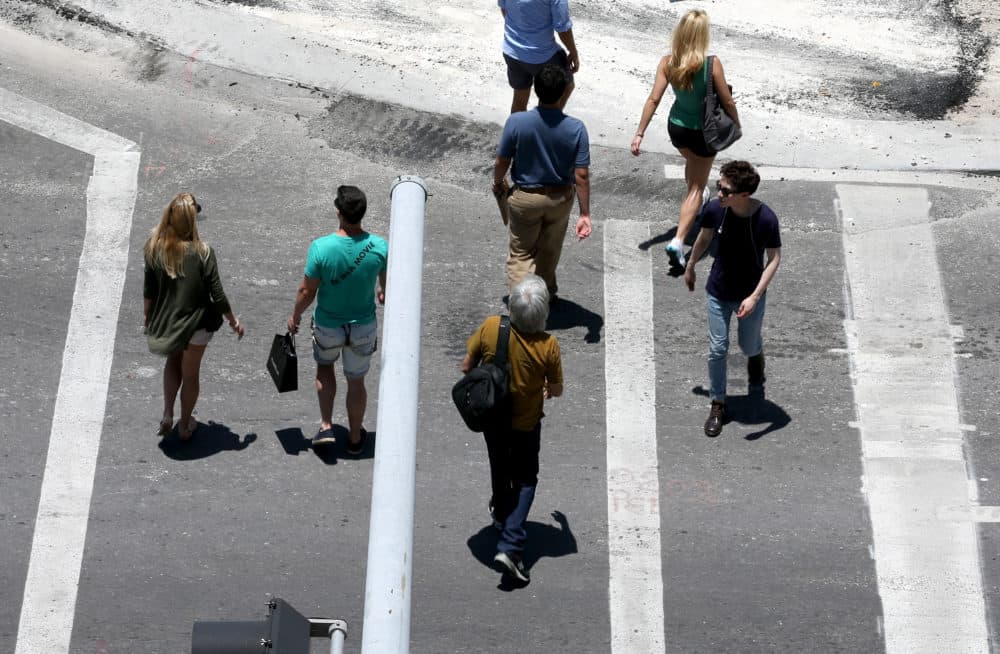Advertisement
Florida Is The Most Dangerous State For Pedestrians In The U.S., Report Finds

Florida is the most dangerous state in the country for pedestrians, and the Orlando metro area is the most dangerous in the state, according to a new report by Smart Growth America and the National Complete Streets Coalition.
But why?
Billy Hattaway, the transportation director for the city of Orlando, says the design of most Florida roadways and community developments, high speed limits and lack of safety precautions taken by drivers and pedestrians all contribute to why roadways in Florida, and Orlando in particular, are so dangerous.
"Everyone has a responsibility to share the roadways safely," Hattaway tells Here & Now's Jeremy Hobson.
Hattaway says Orlando is in the process of shaping its Vision Zero plan, joining a growing network of other U.S. cities in an effort to "eliminate all traffic fatalities and severe injuries, while increasing safe, healthy, equitable mobility for all."
Interview Highlights
On why the Orlando metropolitan area is so dangerous
"It's a distinction that all of the Sunbelt cities share and certainly the transportation community of which I've been involved with for 40 years has a role. But it's a combination of the sprawl land development patterns that took place after World War II and the Sunbelt states, of which Orlando, most of our growth took place after Disney came here and in the '60s. And so we have neighborhoods and communities that are all cul-de-saced onto the state and federal arterial system. Because there's not a lot of connectivity between neighborhoods and businesses, it pushes all the travel demand on the roadways. And of course, what the state did is widen those roads to reduce congestion because congestion was the big focus for probably the last 50 years."
On plan of action the city of Orlando is taking
"The city of Orlando has adopted a Vision Zero policy and we've become part of the Vision Zero network. We're one of two cities in the state that have done that. And we're in the process of developing our action plan. We've identified the top three corridors that have the highest crashes. If we can focus on those three corridors then we can have a significant impact on crashes overall."
"We're going to have to focus on pedestrian crossings, improving access across the roads because the signals are far apart, and we will have to work with our police department to help us with enforcement."
Billy Hattaway
On what's causing crashes in Orlando's metropolitan area
"All of these roads are divided highways, so the speeds are higher and they all have transit-dependent users on them. We're going to have to focus on pedestrian crossings, improving access across the roads because the signals are far apart, and we will have to work with our police department to help us with enforcement."
On whether there needs to be a shift in how people get around
"I would say that the downtowns are more dense. I don't know that the suburbs are any more dense than they've ever been. But we have neighborhoods where the homes — the back doors of homes — are 70 feet apart but yet it's 7 miles to get from front door to front door. So that means every trip from one neighborhood to the other has to go out onto an arterial. And by having wider roads, people tend to drive faster and certainly transit would help. But the way that you make transit successful is to have more compact development patterns, which we in Florida do not have a lot of compact development patterns outside of the city core."
On pedestrian safety in Florida
"I think all of the users of our transportation system take transportation safety less seriously than they should. In Florida between 2014 and 2016, we had a 23 percent increase in fatalities statewide on the roadway system that went to around 2,500 to over 3,000. And that's all drivers and all users of the roadway, so it's not just a pedestrian problem."
On cities he's looking to that are doing a good job at reducing pedestrian fatalities
"We're going to look to Portland, which is closer to having similar lane development patterns, because again, it's a city that grew up more so after World War II. They've had significant reductions in fatalities in just over a year."
Julia Corcoran produced this interview and edited it for broadcast with Kathleen McKenna. Serena McMahon adapted it for the web.
This segment aired on January 31, 2019.
